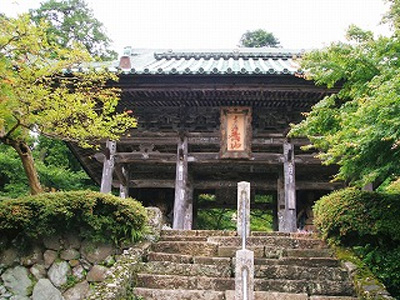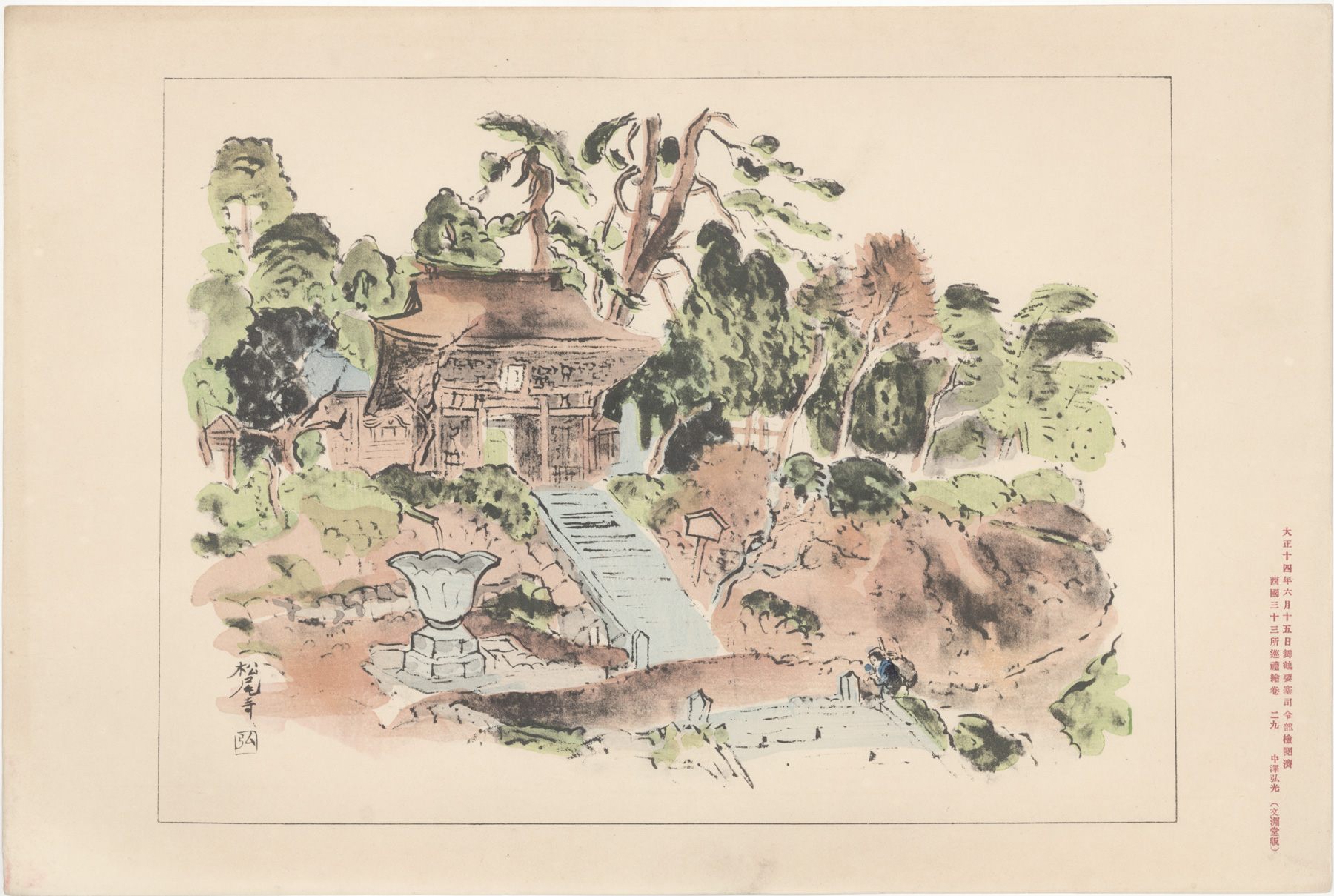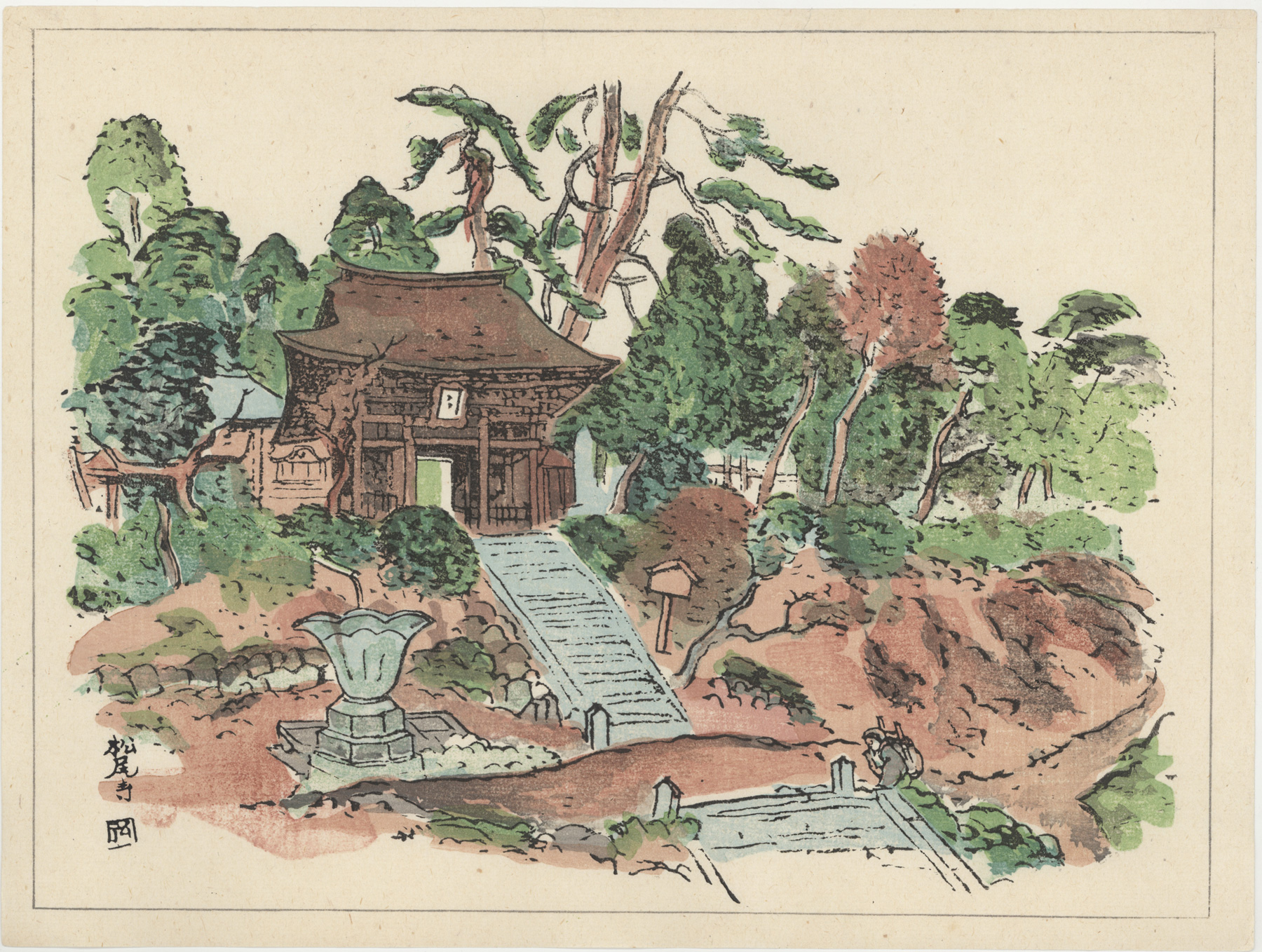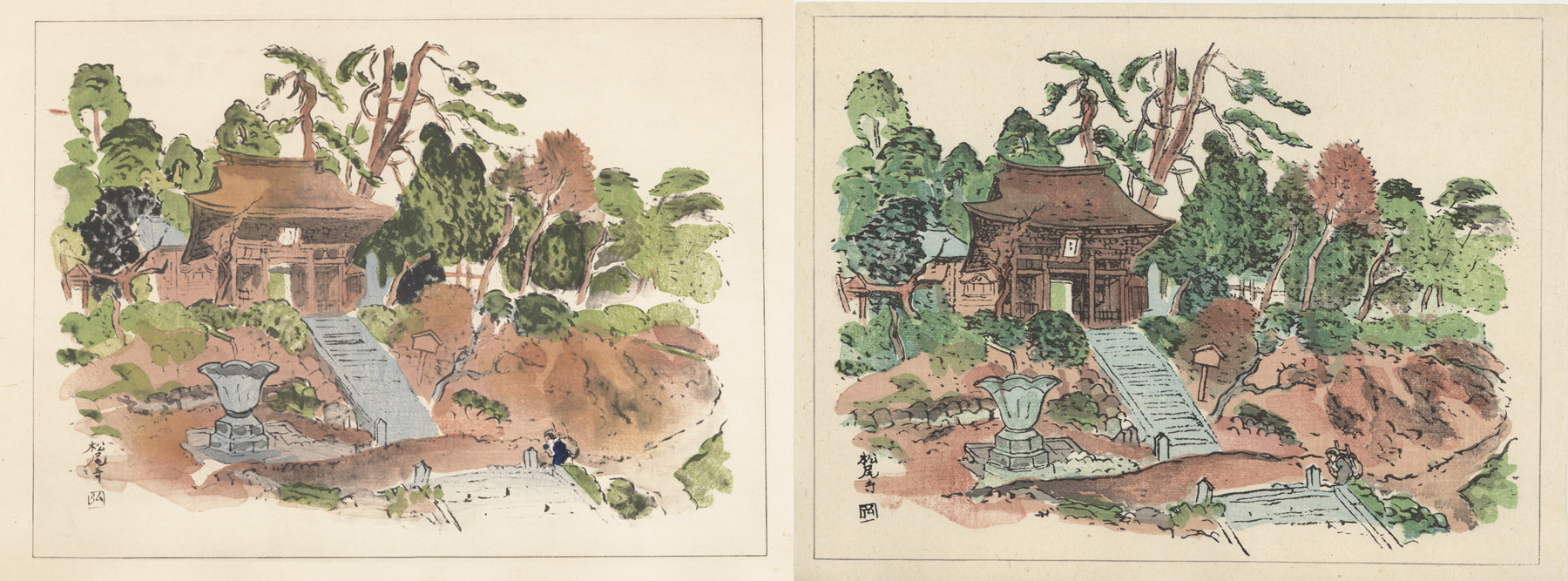About This Print
In this print, Nakazawa depicts the temple gate Niōmon at the entrance to Matsunoo-dera, a Shingon sect Buddhist temple and the 29th temple along the Saigoku Kannon Pilgrimage.
On December 1923, only a few months after the Great Kantō Earthquake devastated the Tokyo area, Nakazawa along with his two friends, the poet Ishikura Suiyō and the artist Akatsuka Chūichi, began their pilgrimage to the thirty-three temples comprising the Saigoku Kannon Pilgrimage, taking seventy-eight days to complete the route.
For more information on their pilgrimage see the article Nakazawa Hiromitsu - Picture Album of the Thirty-Three Pilgrimage Places of the Western Provinces.
Censor Approval


As Matsunoo-dera is located in Maizuru, Kyoto Prefecture, it is perhaps no coincidence that this carries the Maizuru Fort Headquarters censor's approval.
1 Website of the Library of Congress https://blogs.loc.gov/international-collections/2018/04/japanese-censorship-collection-at-the-library-of-congress/
The Temple
Source: "Miracle Stories of the Horse-Headed Bodhisattva of Compassion, Batō Kannon" by Benedetta Lomi appearing in Dharma World January-June 2017, vol. 44, p. 22 and other sources.
Matsunoo-dera, a Shingon sect Buddhist temple, located in on Mount Aoba near Maizuru City, Kyoto Prefecture, is the 29th temple along the Saigoku Kannon Pilgrimage.
"[T]he Matsunoodera saikō keihaku bun the temple's Kamakura-period restoration record], still held at Matsunoodera, explains that Matsunoodera was founded between the Keiun (704–708) and Wado (708–715) eras, when the ascetic Ikō Shōnin—supposedly a Tang monk who is also associated with another temple on the route, Kimiidera, station number two—opened Mount Aoba and established a hermitage there."
The main enshrined image (honzon) of the temple is the bodhisattva Kannon Batō, its statue being unveiled every seventy-seven years.

Niōmon Gate 仁王門
image source: http://www.uranus.dti.ne.jp/gomi-ka/s29matuontera.html
Comparison of 1925 and 1946 Issues
This collection contains prints from both the 1925 and 1946 releases. I prefer the earlier release which has a more painterly quality, likely closer to the artist's original drawing the print was based upon.
As explained further below, the two editions show significant differences suggesting either
extensive touching-up of the original blocks or newly carved blocks
The Saigoku Kannon Pilgrimage (Saigoku sanjūsansho junrei)
Japan's most famous pilgrimage, originating in the 11th century, encompasses 33 Buddhist temples in Western Japan (Kansai region) dedicated to Kannon (bodhisattva Avalokitasvara), the Bodhisattva of Compassion, who hears the cries of the world and assists anyone in distress.
The 33 temples on the approximately 1,000 kilometer pilgrimage route correspond to Kannon's ability to take on 33 different forms. One hundred thousand pilgrims navigate the route in its entirety or part each year.
Note: For a listing of all 33 temples go to https://en.wikipedia.org/wiki/Saigoku_Kannon_Pilgrimage. To access an interactive map of the route and its temples go to https://www.thetempleguy.org/p/saigoku-33-kannon-route.html and scroll down towards the bottom of the page.
About the "Picture Album of the Thirty-Three Pilgrimage Places of the Western Provinces"
First issued in 1925 and reprinted in 1946, the 1925 album contains 58 prints and the 1946 album 59 prints. For detailed discussion of the two editions and additional information on the Saigoku Kannon Pilgrimage see this site's article Nakazawa Hiromitsu - Picture Album of the Thirty-Three Pilgrimage Places of the Western Provinces.
Print Details
IHL Catalog
#2245 and #2413.37 (1925 releases) and #1860 (1946 release) Title or Description Matsunoo-dera (temple 29)
松尾寺 (二十九) Series Picture Album of the Thirty-Three Pilgrimage Places of the Western Provinces
西国三十三所巡礼画巻 Saigoku sanjūsansho junrei gakan Artist Nakazawa Hiromitsu (1874-1964)
Signature  IHL Cat. #2245 and #2413.37 (1925 releases): 中澤弘光 [Nakazawa Hiromitsu] printed in lower right margin as shown left
IHL Cat. #2245 and #2413.37 (1925 releases): 中澤弘光 [Nakazawa Hiromitsu] printed in lower right margin as shown left
IHL Cat. #1860 (1946 release): not signed
Seal of the artist  IHL Cat. #2245 and #2413.37(1925 release)
IHL Cat. #2245 and #2413.37(1925 release)
弘 Hiro IHL Cat. #1860(1946 release)弘 Hiro
IHL Cat. #1860(1946 release)弘 Hiro
Publication Date IHL Cat. #2245 and #2413.37: Published September 28, 1925 大正十四年九月十八日発行 as printed in the 1925 album's colophon (see Album Box with Print of Kannon IHL Cat. 2413).
Note: an earlier date of June 15, 1925 大正十四年六月十五日 appears in the right margin of the print titled Matsunoo-dera [IHL Cat. #2245], the only print in the 1925 album which carries a date. This earlier date, however, is the date that the censor's approval was obtained, as further explained on this site's web page for Matsunoo-dera, rather than the publishing date.
IHL Cat. #1860: January 18, 1946 昭和二十一年一月十八日発行 [Individual prints in the 1946 release are not dated. This date taken from a 1946 album colophon.] Publisher 發行者 金尾種次郎 publisher Kanao Tanejirō
發兌元 金尾文淵堂 publishing house Kanao Bun'endō
 IHL Cat. #2245 and #2413.37 (1925 release): 文淵堂版 [Bun'endō han] printed in lower right margin as shown left
IHL Cat. #2245 and #2413.37 (1925 release): 文淵堂版 [Bun'endō han] printed in lower right margin as shown left
IHL Cat. #1860 (1946 release): no publisher seal Carver Okada Seijirō 岡田清次郎
Note: the album's colophon (see Album Box with Print of Kannon IHL Cat. 2413) lists two carvers, the above well-known Okada Seijirō and 大倉藤太郎, possibly read Okura Tōtarō, who I can find no information on. Printer IHL Cat. #2245 and #2413.37 (1925 releases): Nishimura Kumakichi 西村熊吉
Note: the colophon for the 1925 album (see Album Box with Print of Kannon IHL Cat. 2413) lists three printers, the above well-known Nishmura Kumakichi; 山県秀助, possibly read Yamagata Hidesuki, who I can find no information on, and 松本兄弟堂, a company founded in Osaka by Matsumoto Kisaburō 松本喜三郎 in 1923, which I believe did the letterpress printing.
IHL Cat. #1860 (1946 release): Nishimura Kumakichi 西村熊吉 and
Takagi Seikō (Takagi Kiyomitsu?) 高木淸光
Note: the above information is taken from the colophon included in the 1946 release. I could find no information on the second printer listed for the 1946 release 高木淸光.
Note on Nishimura Kumakichi: listed as one of the printers for both the 1925 and 1946 release, there is some uncertainty about the date of his death, although a birth date, either 1861 or 1862 [Guide to Modern Japanese Woodblock Prints, Merritt, p. 223], is generally accepted. A death date of 1941 is sometimes given and 1955 has been suggested, but Merritt provides no date of death. If he truly did the printing for the 1946 release he would have been around 85 at that time. Impression IHL Cat. #2245 (1925 release): excellent
IHL Cat. #2413.37 (1925 release): excellent
IHL Cat. #1860 (1946 release): excellent
Colors IHL Cat. #2245 (1925 release): excellent
IHL Cat. #2413.37 (1925 release): excellent
IHL Cat. #1860 (1946 release): excellent Condition IHL Cat. #2245 (1925 release): excellent - minor foxing lower right corner
IHL Cat. #2413.37 (1925 release): good - light overall toning and minor marks
IHL Cat. #1860 (1946 release): excellent - mounting residue in two spots along upper margin verso
Genre shin hanga; shasei kikō (sketch-tour) Miscellaneous  temple/print number 29 appearing in the right margin of the 1925 release
temple/print number 29 appearing in the right margin of the 1925 release Format horizontal oban
H x W Paper
IHL Cat. #2245 (1925 release): 10 1/16 x 15 1/4 in. ( 25.6 x 38.7 cm)
IHL Cat. #2413.37 (1925 release): 10 1/16 x 15 1/4 in. ( 25.6 x 38.7 cm)
IHL Cat. #1860 (1946 release): 9 x 12 in. (22.9 x 30.5 cm)
H x W Image
IHL Cat. #2245 (1925 release): 8 7/16 x 11 5/8 in. (21.4 x 29.5 cm)
IHL Cat. #2413.37 (1925 release): 8 7/16 x 11 5/8 in. (21.4 x 29.5 cm)
IHL Cat. #1860 (1946 release): 8 3/8 x 11 5/16 in. (21.3 x 28.3 cm)
Literature Nakazawa Hiromitsu kenkyū: Hon karano kenshō, Hiromitsu Nakazawa, Mitsunobu Satō, et. al., Mitsui Kōkei, Tokyo, 2006, p. 46-48. Collections This Print
National Diet Library Call Number 寄別7-8-2-5 (1925 album, no images displayed); National Library Board, Singapore BRN:9854371 (entire 1946 album, no images shown); British Library System number: 017018582 (entire 1946 album, no images shown); Harvard Yenching Library HOLLIS number 990082993710203941 (1925 album, no images displayed)
| IHL Catalog | #2245 and #2413.37 (1925 releases) and #1860 (1946 release) | ||
| Title or Description | Matsunoo-dera (temple 29) 松尾寺 (二十九) | ||
| Series | Picture Album of the Thirty-Three Pilgrimage Places of the Western Provinces 西国三十三所巡礼画巻 Saigoku sanjūsansho junrei gakan | ||
| Artist | Nakazawa Hiromitsu (1874-1964) | ||
| Signature |  IHL Cat. #2245 and #2413.37 (1925 releases): 中澤弘光 [Nakazawa Hiromitsu] printed in lower right margin as shown left IHL Cat. #2245 and #2413.37 (1925 releases): 中澤弘光 [Nakazawa Hiromitsu] printed in lower right margin as shown leftIHL Cat. #1860 (1946 release): not signed | ||
| Seal of the artist |
| ||
| Publication Date | IHL Cat. #2245 and #2413.37: Published September 28, 1925 大正十四年九月十八日発行 as printed in the 1925 album's colophon (see Album Box with Print of Kannon IHL Cat. 2413). Note: an earlier date of June 15, 1925 大正十四年六月十五日 appears in the right margin of the print titled Matsunoo-dera [IHL Cat. #2245], the only print in the 1925 album which carries a date. This earlier date, however, is the date that the censor's approval was obtained, as further explained on this site's web page for Matsunoo-dera, rather than the publishing date. IHL Cat. #1860: January 18, 1946 昭和二十一年一月十八日発行 [Individual prints in the 1946 release are not dated. This date taken from a 1946 album colophon.] | ||
| Publisher | 發行者 金尾種次郎 publisher Kanao Tanejirō 發兌元 金尾文淵堂 publishing house Kanao Bun'endō  IHL Cat. #2245 and #2413.37 (1925 release): 文淵堂版 [Bun'endō han] printed in lower right margin as shown left IHL Cat. #2245 and #2413.37 (1925 release): 文淵堂版 [Bun'endō han] printed in lower right margin as shown leftIHL Cat. #1860 (1946 release): no publisher seal | ||
| Carver | Okada Seijirō 岡田清次郎 Note: the album's colophon (see Album Box with Print of Kannon IHL Cat. 2413) lists two carvers, the above well-known Okada Seijirō and 大倉藤太郎, possibly read Okura Tōtarō, who I can find no information on. | ||
| Printer | IHL Cat. #2245 and #2413.37 (1925 releases): Nishimura Kumakichi 西村熊吉 Note: the colophon for the 1925 album (see Album Box with Print of Kannon IHL Cat. 2413) lists three printers, the above well-known Nishmura Kumakichi; 山県秀助, possibly read Yamagata Hidesuki, who I can find no information on, and 松本兄弟堂, a company founded in Osaka by Matsumoto Kisaburō 松本喜三郎 in 1923, which I believe did the letterpress printing. IHL Cat. #1860 (1946 release): Nishimura Kumakichi 西村熊吉 and Takagi Seikō (Takagi Kiyomitsu?) 高木淸光 Note: the above information is taken from the colophon included in the 1946 release. I could find no information on the second printer listed for the 1946 release 高木淸光. Note on Nishimura Kumakichi: listed as one of the printers for both the 1925 and 1946 release, there is some uncertainty about the date of his death, although a birth date, either 1861 or 1862 [Guide to Modern Japanese Woodblock Prints, Merritt, p. 223], is generally accepted. A death date of 1941 is sometimes given and 1955 has been suggested, but Merritt provides no date of death. If he truly did the printing for the 1946 release he would have been around 85 at that time. | ||
| Impression | IHL Cat. #2245 (1925 release): excellent IHL Cat. #2413.37 (1925 release): excellent IHL Cat. #1860 (1946 release): excellent | ||
| Colors | IHL Cat. #2245 (1925 release): excellent IHL Cat. #2413.37 (1925 release): excellent IHL Cat. #1860 (1946 release): excellent | ||
| Condition | IHL Cat. #2245 (1925 release): excellent - minor foxing lower right corner IHL Cat. #2413.37 (1925 release): good - light overall toning and minor marks IHL Cat. #1860 (1946 release): excellent - mounting residue in two spots along upper margin verso | ||
| Genre | shin hanga; shasei kikō (sketch-tour) | ||
| Miscellaneous |  | ||
| Format | horizontal oban | ||
| H x W Paper | IHL Cat. #2245 (1925 release): 10 1/16 x 15 1/4 in. ( 25.6 x 38.7 cm) IHL Cat. #2413.37 (1925 release): 10 1/16 x 15 1/4 in. ( 25.6 x 38.7 cm) IHL Cat. #1860 (1946 release): 9 x 12 in. (22.9 x 30.5 cm) | ||
| H x W Image | IHL Cat. #2245 (1925 release): 8 7/16 x 11 5/8 in. (21.4 x 29.5 cm) IHL Cat. #2413.37 (1925 release): 8 7/16 x 11 5/8 in. (21.4 x 29.5 cm) IHL Cat. #1860 (1946 release): 8 3/8 x 11 5/16 in. (21.3 x 28.3 cm) | ||
| Literature | Nakazawa Hiromitsu kenkyū: Hon karano kenshō, Hiromitsu Nakazawa, Mitsunobu Satō, et. al., Mitsui Kōkei, Tokyo, 2006, p. 46-48. | ||
| Collections This Print | National Diet Library Call Number 寄別7-8-2-5 (1925 album, no images displayed); National Library Board, Singapore BRN:9854371 (entire 1946 album, no images shown); British Library System number: 017018582 (entire 1946 album, no images shown); Harvard Yenching Library HOLLIS number 990082993710203941 (1925 album, no images displayed) |
last revision:
12/20/2020
7/4/2020
6/30/2020
2/22/2020
1/6/2020 created





